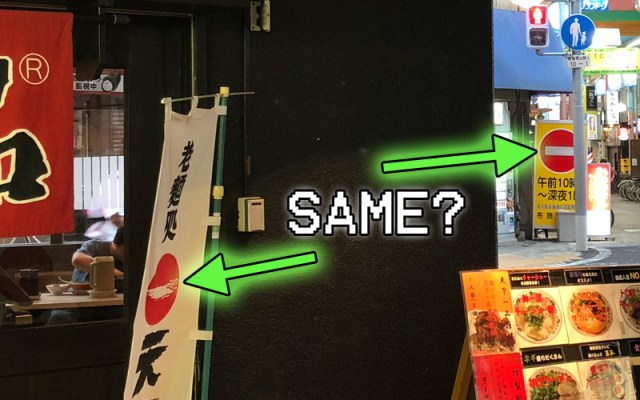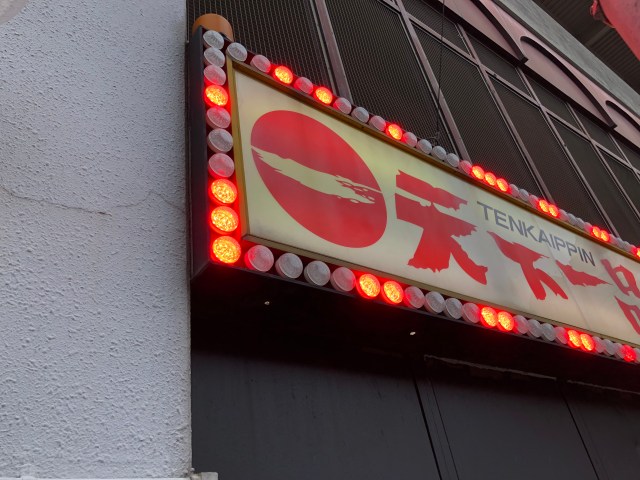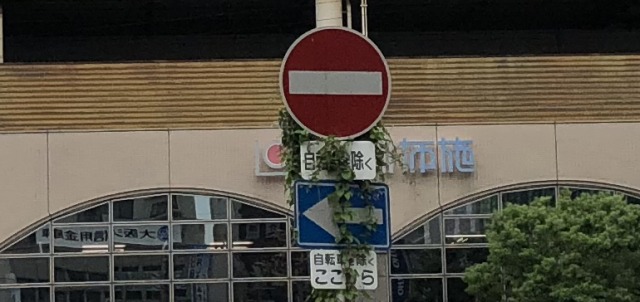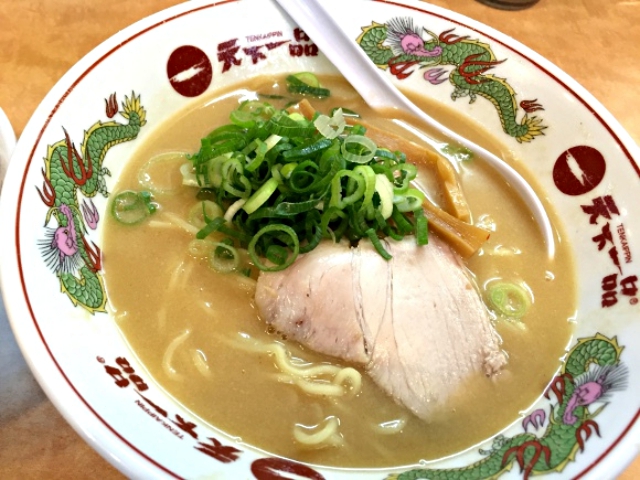
Although in the cars’ defense I never really knew what that logo was supposed to be either.
The continuing automation of cars is sure to pose a number of societal changes that we may not even be able to begin to imagine. Aside from the obvious changes to the way we get around and transport goods, the increasing intelligence means we will have to communicate with these machines more and more.
Vehicular misunderstandings aren’t a new problems, decades-old educational works such as Knight Rider and Maximum Overdrive have each highlighted how communication between human and car can go terribly right and terribly wrong respectively.
Even in the real world, signs of miscommunications are already beginning to emerge. Motorist and Twitter user Yukiesu (@yuk381) posted a scene from his driver seat in front of a Tenkaippin ramen store. In it, despite just sitting in the parking lot, a warning on his dashboard is indicating that the car sees a “Do Not Enter” sign.
▼ You can see the car misinterpreting the sign
with the little red circle in the bottom right.
ホンダの人工知能が「天下一品」の看板と「進入禁止」の標識を見分けられないので、車種によっては天下一品に近づくだけで人間に進入禁止の警告を出してしまう件、嘘だろと思ってたら本当に進入禁止になって笑った pic.twitter.com/3Qk1UVIxox
— ゆきえす🐎 (@yuk381) September 12, 2018
As Yukiesu points out, this appears to be a feature of Honda cars. Past encounters also confirm that cars equipped with Honda SENSING tend to be the ones that react to the ramen chain’s signage.
▼ Another misinterpretation, this time
shown in the bottom center of the photo.
N-BOXのHonda SENSING、標識認識機能で⛔(車両進入禁止)も検知するけど、これに気付いたときはホンマに爆笑したwww初っぱなから良き思い出😆 pic.twitter.com/NwB5NUpJhX
— Run@GP4🌿 (@BleuVvvRunner) December 4, 2017
It’s something that only a few people noticed before, but when looking at them side-by-side, the Tenkaippin logo and a Do Not Enter symbol are awfully similar.
▼ A “Do Not Enter” sign…
▼ …and a “Tenkaippin” sign. Hmm, wait a minute….
I also never really thought about it before, but what is that logo supposed to be anyway? I just assumed that it was a little cloud floating past the iconic rising sun as seen on Japan’s national flag. Given that then name Tenkaippin loosely translates to “The best stuff south of heaven,” it’s kind of a fitting visual.
The internet has other theories too. Another obvious possibility is that the white line represents the kanji character for “one” again referring to the use of “number one” or “best” in the name. That being said, the stroke is a little wonky for a “one.”
Then there’s a whole school of thought that the logo was always intended to be a “Do Not Enter” sign. Although that might seem counterintuitive for a business, the prevailing theory is that Tenkaippin has a unique taste that they do not compromise for picky eaters. So if you don’t like it, just read the sign pal.
There’s also the suggestion that the sign is referring to the soup itself, meaning that it’s perfect the way it is so you shouldn’t put anything else in there. In other words, its a message for additional seasonings: Do Not Enter.
▼ Food only goes out of this bowl, not in.
Whatever the case may be, it is certainly turning off cars. It’s a warning that when designing ads and signs that go out in the public we should be considerate of our simple-sighted two-ton friends as well, so as not to throw them off their game.
On the other hand, with the rising trend of cars slamming into storefronts in Japan, Tenkaippin may be onto something, as I’ve never heard of a car crashing into one of their locations. Perhaps 7-Eleven should adopt a more stop-sign like logo for their own safety.
Source: Twitter/@yuk381, Hachima Kiko, Naver Matome
Images: SoraNews24




 Hayao Miyazaki says Happy New Year to Studio Ghibli fans with new art for Year of the Horse
Hayao Miyazaki says Happy New Year to Studio Ghibli fans with new art for Year of the Horse We revisited Sweets Paradise after a decade to see if Japan’s dessert buffet still delivers
We revisited Sweets Paradise after a decade to see if Japan’s dessert buffet still delivers One Piece devil fruit ice cream coming back to Baskin-Robbins Japan
One Piece devil fruit ice cream coming back to Baskin-Robbins Japan Pizza Hut Japan’s hot lucky bags are perfect for a New Year’s pizza party
Pizza Hut Japan’s hot lucky bags are perfect for a New Year’s pizza party We try the new Famichiki Burger from Family Mart
We try the new Famichiki Burger from Family Mart Hayao Miyazaki says Happy New Year to Studio Ghibli fans with new art for Year of the Horse
Hayao Miyazaki says Happy New Year to Studio Ghibli fans with new art for Year of the Horse We revisited Sweets Paradise after a decade to see if Japan’s dessert buffet still delivers
We revisited Sweets Paradise after a decade to see if Japan’s dessert buffet still delivers One Piece devil fruit ice cream coming back to Baskin-Robbins Japan
One Piece devil fruit ice cream coming back to Baskin-Robbins Japan Pizza Hut Japan’s hot lucky bags are perfect for a New Year’s pizza party
Pizza Hut Japan’s hot lucky bags are perfect for a New Year’s pizza party We try the new Famichiki Burger from Family Mart
We try the new Famichiki Burger from Family Mart Winter walking event takes you around Totoro forest loved by Hayao Miyazaki
Winter walking event takes you around Totoro forest loved by Hayao Miyazaki Dragon Quest Burgers and Slime drinks are coming to McDonald’s Japan【Video】
Dragon Quest Burgers and Slime drinks are coming to McDonald’s Japan【Video】 Japanese AI device reads stories to your kid with your voice, even if you’ve never read them【Vid】
Japanese AI device reads stories to your kid with your voice, even if you’ve never read them【Vid】 Japan’s deadliest food claims more victims, but why do people keep eating it for New Year’s?
Japan’s deadliest food claims more victims, but why do people keep eating it for New Year’s? Final Fantasy and Shinkansen announce collaboration with in-train audio play, SD art and merch
Final Fantasy and Shinkansen announce collaboration with in-train audio play, SD art and merch Starbucks Japan ready to get Year of the Horse started with adorable drinkware and plushies【Pics】
Starbucks Japan ready to get Year of the Horse started with adorable drinkware and plushies【Pics】 Cyberpunk anime meets traditional culture in Ghost in the Shell gold leaf Japanese changing screens
Cyberpunk anime meets traditional culture in Ghost in the Shell gold leaf Japanese changing screens 7 great places to see Mt. Fuji from without having to climb it
7 great places to see Mt. Fuji from without having to climb it Hello Kitty Choco Egg figures are an adorable trip through three periods of Japanese pop culture【Pics】
Hello Kitty Choco Egg figures are an adorable trip through three periods of Japanese pop culture【Pics】 7-Eleven Japan’s ramen-cooking robot whipped us up a bowl of noodles【Taste test】
7-Eleven Japan’s ramen-cooking robot whipped us up a bowl of noodles【Taste test】 We found possibly the quietest Japanese-style hotel in Tokyo’s bustling Shinjuku district
We found possibly the quietest Japanese-style hotel in Tokyo’s bustling Shinjuku district Japan’s otoshidama tradition of giving kids money at New Year’s gets a social welfare upgrade
Japan’s otoshidama tradition of giving kids money at New Year’s gets a social welfare upgrade Sumo Sanrio! Hello Kitty and pals team up with Japan Sumo Association for new merch【Pics】
Sumo Sanrio! Hello Kitty and pals team up with Japan Sumo Association for new merch【Pics】 More Than a Capsule Stay: Why Solo Travelers Choose “global cabin Yokohama Chinatown”
More Than a Capsule Stay: Why Solo Travelers Choose “global cabin Yokohama Chinatown” Japan’s oldest largetooth sawfish in captivity back on display in Mie Prefecture
Japan’s oldest largetooth sawfish in captivity back on display in Mie Prefecture 7-Eleven Japan starts new temporary luggage storage service in over 300 branches
7-Eleven Japan starts new temporary luggage storage service in over 300 branches Disillusionment at Tsukiji’s tourist-target prices led us to a great ramen restaurant in Tokyo
Disillusionment at Tsukiji’s tourist-target prices led us to a great ramen restaurant in Tokyo Starbucks teams up with 166-year-old Kyoto doll maker for Year of the Horse decorations【Photos】
Starbucks teams up with 166-year-old Kyoto doll maker for Year of the Horse decorations【Photos】 Tokyo considering law requiring more trash cans following litter increase in heavily touristed area
Tokyo considering law requiring more trash cans following litter increase in heavily touristed area Tokyo’s Tsukiji sushi neighborhood asks tour groups to stay away for the rest of the month
Tokyo’s Tsukiji sushi neighborhood asks tour groups to stay away for the rest of the month Tokyo event lets you travel back in time, for free, to celebrate 100 years since Showa era start
Tokyo event lets you travel back in time, for free, to celebrate 100 years since Showa era start Sanrio theme park in Japan announces plans to expand into a Sanrio resort
Sanrio theme park in Japan announces plans to expand into a Sanrio resort Japan may add Japanese language proficiency, lifestyle classes to permanent foreign resident requirements
Japan may add Japanese language proficiency, lifestyle classes to permanent foreign resident requirements Stamina-destroying “Paralysis Noodles” are Tokyo’s newest over-the-top ramen innovation
Stamina-destroying “Paralysis Noodles” are Tokyo’s newest over-the-top ramen innovation Survey asks foreign tourists what bothered them in Japan, more than half gave same answer
Survey asks foreign tourists what bothered them in Japan, more than half gave same answer Japan’s human washing machines will go on sale to general public, demos to be held in Tokyo
Japan’s human washing machines will go on sale to general public, demos to be held in Tokyo We deeply regret going into this tunnel on our walk in the mountains of Japan
We deeply regret going into this tunnel on our walk in the mountains of Japan Studio Ghibli releases Kodama forest spirits from Princess Mononoke to light up your home
Studio Ghibli releases Kodama forest spirits from Princess Mononoke to light up your home Major Japanese hotel chain says reservations via overseas booking sites may not be valid
Major Japanese hotel chain says reservations via overseas booking sites may not be valid Put sesame oil in your coffee? Japanese maker says it’s the best way to start your day【Taste test】
Put sesame oil in your coffee? Japanese maker says it’s the best way to start your day【Taste test】 No more using real katana for tourism activities, Japan’s National Police Agency says
No more using real katana for tourism activities, Japan’s National Police Agency says Starbucks Japan reveals new sakura drinkware collection, inspired by evening cherry blossoms
Starbucks Japan reveals new sakura drinkware collection, inspired by evening cherry blossoms Updated cherry blossom forecast shows extra-long sakura season for Japan this year
Updated cherry blossom forecast shows extra-long sakura season for Japan this year Winter walking event takes you around Totoro forest loved by Hayao Miyazaki
Winter walking event takes you around Totoro forest loved by Hayao Miyazaki Dragon Quest Burgers and Slime drinks are coming to McDonald’s Japan【Video】
Dragon Quest Burgers and Slime drinks are coming to McDonald’s Japan【Video】 Japanese AI device reads stories to your kid with your voice, even if you’ve never read them【Vid】
Japanese AI device reads stories to your kid with your voice, even if you’ve never read them【Vid】 Japan’s deadliest food claims more victims, but why do people keep eating it for New Year’s?
Japan’s deadliest food claims more victims, but why do people keep eating it for New Year’s? Final Fantasy and Shinkansen announce collaboration with in-train audio play, SD art and merch
Final Fantasy and Shinkansen announce collaboration with in-train audio play, SD art and merch Tokyo’s new burger chain isn’t new, is disappointing, tasty, and hopeful all at once【Taste test】
Tokyo’s new burger chain isn’t new, is disappointing, tasty, and hopeful all at once【Taste test】 The mystery of the phantom “sake pass card” at Japanese alcohol vending machines
The mystery of the phantom “sake pass card” at Japanese alcohol vending machines Perfectly recreated 1960s Japanese apartment lets museum visitors go back to mid-Showa era【Pics】
Perfectly recreated 1960s Japanese apartment lets museum visitors go back to mid-Showa era【Pics】 From beef bowl to beef pouch? Taste testing Yoshinoya’s instant gyudon packs
From beef bowl to beef pouch? Taste testing Yoshinoya’s instant gyudon packs The beautiful cosplayers, models, and booth displays of Day 2 of Tokyo Game Show
The beautiful cosplayers, models, and booth displays of Day 2 of Tokyo Game Show Sushi for breakfast? Our under-1,000-yen breakfast with Hama Sushi’s new morning menu
Sushi for breakfast? Our under-1,000-yen breakfast with Hama Sushi’s new morning menu
Leave a Reply